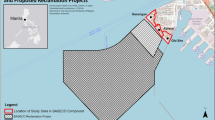Abstract
It is difficult to assess the value of environmental damage, such as that related to polluted farmlands, because of no markets exist that are relevant to such valuation. This paper applies the contingent valuation method to measure the compensation value considered acceptable to those working and living on polluted farmlands. Baiyin and Jinchang Cities in northwest China are chosen for a case study based on 382 completed questionnaires. It is shown that a willingness to accept (WTA) measure is necessary for damage assessment and is reasonable when those negatively affected by pollution of farmlands also hold relevant property rights. The study applied two methods (the Tobit model and the Logit model) to estimate the MWTA compensation value. Based on our findings, Logit model could be more effective in detecting and correcting respondent bias. The Logit model indicates that the set of explanatory variables considered influences respondents’ WTA decisions which is positively related to farmland size and family size, and is also affected by income and education levels.


Similar content being viewed by others
References
Ahumada I, Mendoza J, Navarrete E, Ascar L (1999) Sequential extraction of heavy metals in soils irrigated with wastewater. Commun Soil Sci Plan 30:1507–1519
Alexander PD, Alloway BJ, Dourado AM (2006) Genotypic variations in the accumulation of Cd, Cu, Pb and Zn exhibited by six commonly grown vegetables. Environ Pollut 144:736–745
Bateman IJ, Day BH, Georgiou S, Lake I (2006) The aggregation of environmental benefit values: welfare measures, distance decay and total WTP. Ecol Econ 60:450–460
Boyle KJ, MacDonald HF, Cheng HT, McCollum DW (1998) Bid design and yea saying in single-bounded, dichotomous-choice questions. Land Econ 74:49–64
Carson RT, Groves T (2007) Incentive and informational properties of preference questions. Environ Resour Econ 37:181–210
Cooper JC (1993) Optimal Bid selection for dichotomous choice contingent valuation surveys. J Environ Manag 24:25–40
del Saz-Salazar S, Garcia-Menendez L, Feo-Valero M (2012) Meeting the environmental challenge of port growth: a critical appraisal of the contingent valuation method and an application to Valencia Port, Spain. Ocean Coast Manag 59:31–39
Greger M, Malm T, Kautsky L (2007) Heavy metal transfer from composted macroalgae to crops. Eur J Agron 26:257–265
Groothuis PA, Van Houtven G, Whitehead JC (1998) Using contingent valuation to measure the compensation required to gain community acceptance of a LULU: the case of a hazardous waste disposal facility. Publ Finance Rev 26:231–249
Halstead JM, Lindsay BE, Brown CM (1991) Use of the Tobit-model in contingent valuation—experimental-evidence from the Pemigewasset Wilderness area. J Environ Manag 33:79–89
Han FX, Kingery WL, Hargreaves JE, Walker TW (2007) Effects of land uses on solid-phase distribution of micronutrients in selected vertisols of the Mississippi River Delta. Geoderma 142:96–103
Hanemann WM (1989) Welfare evaluations in contingent valuation—experiments with discrete response data—reply. Am J Agr Econ 71:1057–1061
Ibrahim MA (2012) Using econometric analysis of willingness-to-pay to investigate economic efficiency and equity of domestic water services in the West Bank. J SocioEcon 41:485–494
Jorgensen B, Syme G, Bishop B, Nancarrow B (1999) Protest responses in contingent valuation. Environ Resour Econ 14:131–150
Lakhdar A, Iannelli MA, Debez A, Massacci A, Jedidi N, Abdelly C (2010) Effect of municipal solid waste compost and sewage sludge use on wheat (Triticum durum): growth, heavy metal accumulation, and antioxidant activity. J Sci Food Agr 90:965–971
Lee CK, Mjelde JW (2007) Valuation of ecotourism resources using a contingent valuation method: the case of the Korean DMZ. Ecol Econ 63:511–520
Li Y, Wang YB, Gou X, Su YB, Wang G (2006) Risk assessment of heavy metals in soils and vegetables around non-ferrous metals mining and smelting sites, Baiyin, China. J Environ Sci 18:1124–1134
Loomis J, Kent P, Strange L, Fausch K, Covich A (2000) Measuring the total economic value of restoring ecosystem services in an impaired river basin: results from a contingent valuation survey. Ecol Econ 33:103–117
Nan ZR, Zhao CY (2000) Heavy metal concentrations in gray calcareous soils of Baiyin region, Gansu Province, PR China. Water Air Soil Poll 118:131–141
Oskarsson A, Widell A, Olsson IM, Grawe KP (2004) Cadmium in food chain and health effects in sensitive population groups. Biometals 17:531–534
Qiao XL, Luo YM, Christie P, Wong MH (2003) Chemical speciation and extractability of Zn, Cu and Cd in two contrasting biosolids-amended clay soils. Chemosphere 50:823–829
Scheaffer RL, Mendenhall W, Ott RL (2006) Elementary survey sampling, 6th edn. Duxbury Press, Boston 126
Schlapfer F (2006) Survey protocol and income effects in the contingent valuation of public goods: a meta-analysis. Ecol Econ 57:415–429
Wang X, Nan ZR, Ding WG, Wang SL, Wang ZW, Yang YM, Wang B (2012) Chemical fraction of heavy metals in an oasis soil and their bioavailability to cole crops. Arid Land Res Manag 26:166–180
Wang X, Ding WG, Nan ZR, Liao Q, Wu WF (2013) Fraction of Cd in oasis soil and its bioavailability to commonly grown crops in northwest China. Environ Earth Sci 70:471–479
Acknowledgments
This work was supported by the National Natural Science Foundation of China (NSFC 41572332) the Fundamental Research Funds for the Central Universities in Lanzhou University (lzujbky-2015-142, lzujbky-2015-k10) and the Key Projects in the National Science and Technology Pillar Program (2012BAC19B09).
Author information
Authors and Affiliations
Corresponding author
Rights and permissions
About this article
Cite this article
Wang, X., Zhang, Y., Huang, Z. et al. Assessing willingness to accept compensation for polluted farmlands: a contingent valuation method case study in northwest China. Environ Earth Sci 75, 179 (2016). https://doi.org/10.1007/s12665-015-4872-y
Received:
Accepted:
Published:
DOI: https://doi.org/10.1007/s12665-015-4872-y




